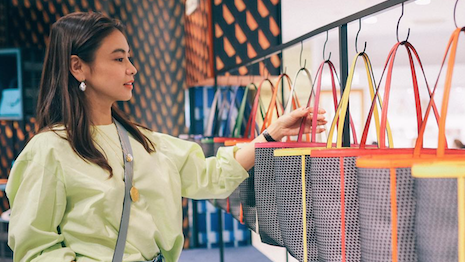- About
- Subscribe Now
- New York,
September 11, 2019

 Affluent Japanese women prefer in-store shopping experiences. Image credit: Valextra
Affluent Japanese women prefer in-store shopping experiences. Image credit: Valextra
Luxury brands that are looking to be competitive in Asia would be wise to look beyond China and learn more about the habits of affluent Japanese and South Korean women as their spending power grows.
According to new findings from Agility Research & Strategy, more than 85 percent of Japanese and South Korean women are confident in their luxury purchases. Although both demographics consider themselves to be rational, rather than emotional shoppers, Korean women are more likely to be influenced by social media.
“Even if they are close to each other geographically, the luxury shopping personalities of these two consumer groups are different,” said Amrita Banta, managing director at Agility Research & Strategy, Singapore. “It is important to understand these nuances in order to tailor fit market strategies accordingly.
“Japanese women are more spontaneous in their purchases compared to Korean women, who like to plan their luxury purchases,” she said. “This was surprising as we would have expected that the Japanese, who tend to be more rational buyers, would be the planners.”
Demographic differentiations
The population of high-net-worth women is on the rise in Japan and South Korea as more women enter the workforce or become entrepreneurs. Similarly to affluent women in China, many of these consumers are self-made.
More than half of Japanese and South Korean HNW women own property domestically for their own use, although South Korean women hold an edge over Japanese affluents, 80 to 58 percent.
However, affluent Japanese and South Korean women have different approaches to their luxury purchases.
Affluent Japanese women want to spend more on luxury watch brands, such as Cartier. Image credit: Cartier
While almost three-quarters of Japanese women consider themselves to be spontaneous shoppers, 71 percent also believe they are rational about their luxury purchases. Only six in 10 Korean women report being rational shoppers, but 84 percent also admit to planning their luxury purchases.
Agility finds that South Korean women are more brand loyal than Japanese women, 83 to 53 percent. Sixty percent of Korean affluents also describe themselves as “trendsetters,” while 71 percent of Japanese women are “trend followers” despite their tendency to try to more luxury brands or products.
Both groups of affluent women are also increasing their spending on travel. Korean women tend to travel more internationally, going overseas for both business and leisure purposes, while Japanese women favor domestic trips.
In the next 12 months, Korean women expect to spend more on high-end clothing while Japanese women plan to purchase more luxury watches. Both groups ranked Chanel as their second preferred luxury watch brand, with Cartier the most popular brand in Japan and Korean women favoring Tiffany & Co.
Reaching Asian women
Out of the two demographics, Korean women’s social media habits also more closely mirror those of Chinese consumers. They turn to social media for product discovery and sharing, while 80 percent of Japanese women say they primarily use social media for reading news.
More than a quarter of South Korean female affluents have bought a luxury good after it was recommended by an influencer, compared to 14 percent of Japanese women who have done the same. Nearly 30 percent of Korean women have also shared social media posts of their luxury goods as opposed to just 13 percent of Japanese women.
Luxury brands have already fostered with relationships with KOLs in an effort to connect with Asian audiences, particularly in South Korea.
Italian leather goods company Tod’s has featured K-pop idol Krystal in numerous campaigns over the years.
While the brand is well known in both Europe and the U.S., it has recently been making overtures towards the growing Asian luxury market with frequent collaborations with South Korean pop sensation Krystal, who has appeared in a number of campaigns for Tod’s (see story).
French fashion house Chanel also worked to bridge the gap between East and West in its Gabrielle handbag campaign, which included a short film starring South Korea’s G-Dragon.
In addition to the bridging between Eastern and Western fashion sensibilities, the G-Dragon film also played with juxtaposing scenes of nature and peace with scenes of modernity and chaos. G-Dragon is a perfect fit for this theme, given his androgynous and eclectic aesthetic (see story).
“Given that Japanese women are more spontaneous, it is important for brands to focus on in-store experiences and strategy to win among this group,” Ms. Banta said. “While to attract Korean women, online research channels, particularly social media, are key.”
Share your thoughts. Click here